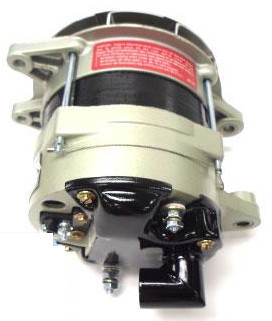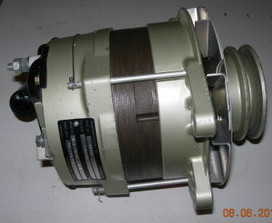Someone asked me this the other day and I didn’t really have a decent answer, apart from the obvious that 24V/28V can deliver 2x the power for the same current (and cable losses).
But I have just seen a good case for 24V/28V. A load analysis of a 12V TB20 is really close to the capacity of a normal 70A alternator… And operating the landing gear probably takes it outside the 70A especially if you have the taxi and landing lights on and they aren’t the LED replacements.
OK, I’ll bite… What is normal about a 70 Amp alternator?
And how does a 24V system help? I assume that the same (or same price/complexity/weight/…) alternator won’t provide 70A at 24V than it does at 12V?
I believe the 28v system is to provide a still low voltage system that has less weight in the wiring than a 12/14v system would need.
I assume that the same (or same price/complexity/weight/…) alternator won’t provide 70A at 24V than it does at 12V?
Not quite but you aren’t far away. The two are close to the same size.
Obviously the 24V 70A one will need 2x more power to turn it at 70A than the 12V one.
It is the same with the B&C alternators. They are all an off the shelf DENSO 12V model, with different voltage regulators, but the 24V “configuration” needs a bit more RPM. I spoke to the guy who developed that product range, about 25 years ago.
24V 8521LS

12V ALX 8421

Cessna went from 12V to 24V for their whole aircraft line in 1978. Before that, they used aluminium wires because copper was both heavy and expensive. However, the conductivity of aluminium is significantly worse than copper and so the wires had a large diameter. Going to 24V and copper allowed them to save on space and not have a weight penalty.
Higher voltage in energy transmission always has the goal of saving on the conductor.
I assume that the same (or same price/complexity/weight/…) alternator won’t provide 70A at 24V than it does at 12V?
The gauge of the wiring and in the windings of the alternator is solely determined by current, not voltage. So you can spin it at twice the speed and get double the voltage, and it would deliver 70A with no issues (except maybe mechanical).
Or you could boost the current through the field coil, which may require thicker wires there, but not for the main power coils.
So the higher voltage alternator will not weigh appreciably more than the lower voltage version.
@Cobalt, theoretically that seems correct, and yet something feels wrong about it. A device that handles/produces twice the power must be twice as big, for my gut feeling. Perhaps a bit more scientific: the internal resistance of the “secondary” winding does not change, so with double the voltage it will dissipate four times the power? Needs to get rid of all that heat energy, somehow?
Of course @Jason and @achimha are right that by doubling the voltage, one can halve the section of the wire to transmit the same power. For the same reason, domestic power distribution changed from 110V~ to 220V~ somewhere around 1970, here. That saves on copper, but I wonder how much savings is needed there to make up for the weight of the second battery. Because, no mistake, there are no 24V batteries so a 24V plane needs to carry two 12V batteries in series. And obviously the gain will be greater in the more complex aircraft, with their greater amount of wiring.
And, err, still curious to get a reply to #2 …
Jan_Olieslagers wrote:
Because, no mistake, there are no 24V batteries so a 24V plane needs to carry two 12V batteries in series.
24V aircraft batteries have 12 cells that can be smaller than a corresponding 6 cell 12V battery with the same capacity so that the overall battery is very much comparable. A typical SEP 24V sealed lead acid battery costs 600€+ though 
I don’t reply to pure wind-up posts, Jan Oli, and neither should anyone else. It just generates silly threads where I or someone gets into a fight with the usual few people, and people start leaving – which is probably the intention of the 1 or 2 people who keep doing this because one of their old mates got banned…
24V aircraft batteries are common. The better quality ones eg Concorde are pricey but that is not because they are 24V. If you want a cheaper one, buy Gill, but IMHO it isn’t worth it because they fail unpredictably. I got through two Gills and would not have a 3rd.
It is true that 12V car batteries are cheap but then they are of poor quality. I have got through so many £50 batteries in cars over the years. Later on, when I had a Toyotas for 23 years, I went to buying genuine Toyota batteries which at some £200 were almost “aircraft priced” but they lasted much longer. It’s the same story with UPS batteries; nearly all of the replacement ones are fakes (Yuasa etc labelled but fake) and they are a fraction of the price of the real Yuasa ones. I don’t know how but somehow the battery makers have found a way to make crap batteries which are cheap  However, in a kitplane, you can indeed just use a car battery. In fact you could probably use a car battery in a certified plane, depending on the certification regime, because the whole argument of “a battery needs an STC” is really really tenuous once you get away from the European cert regime. But you would be dumb to do that because you will just end up with a dead battery in some god forsaken dump airfield… or worse still after an alternator failure in IMC.
However, in a kitplane, you can indeed just use a car battery. In fact you could probably use a car battery in a certified plane, depending on the certification regime, because the whole argument of “a battery needs an STC” is really really tenuous once you get away from the European cert regime. But you would be dumb to do that because you will just end up with a dead battery in some god forsaken dump airfield… or worse still after an alternator failure in IMC.
An interesting point is that a 24V battery has half the Ah of a 12V one of the same size, so the fact that a 24V system is drawing only half the current is balanced out. So you don’t get more time when the alternator goes…